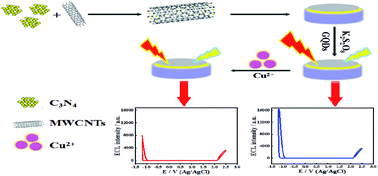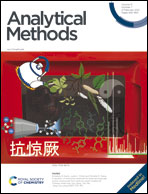A double-potential ratiometric electrochemiluminescence platform based on g-C3N4 nanosheets (g-C3N4 NSs) and graphene quantum dots for Cu2+ detection
Abstract
A new kind of convenient, low-cost double-potential ratiometric ECL sensing platform for the quantification of Cu2+ was developed with carbon nitride nanosheets (g-C3N4 NSs) and graphene quantum dots (GQDs) as ECL luminophores. g-C3N4 NSs mixed with multi-walled carbon nanotubes (MWCNTs) was immobilized on a glass carbon electrode (GCE) and produced strong cathodic ECL at a potential of −1.2 V (vs. Ag/AgCl), while GQDs in the solution gave anodic ECL at +2.5 V. MWCNTs were used here to amplify the ECL signal of g-C3N4 NSs. The addition of Cu2+ causes the cathodic ECL signal from g-C3N4 to decline, while the anodic ECL signal from GQDs remains unchanged. With the anodic ECL signal as an internal reference, a double-potential ratiometric ECL sensing platform for Cu2+ was established. The ratio of the cathodic signal intensity to anodic signal intensity showed a linear response to the Cu2+ concentration over a range from 5.0 × 10−10 to 1.0 × 10−6 mol L−1 and the detection limit was 0.37 nmol L−1 (3σ/S). Such a construction strategy alleviates the interference from the environment and therefore improves the detection accuracy of Cu2+. Compared with other methods for Cu2+ detection, this method is simpler and more sensitive.



 Please wait while we load your content...
Please wait while we load your content...